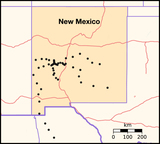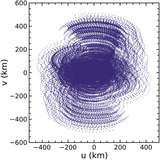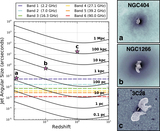Image Details

Caption: Figure 3.
Example of JP model (Jaffe & Perola 1973) spectral ages calculated using the BRATS software (Harwood et al. 2013) demonstrating the need for ngVLA observations spanning a wide range of frequencies. The left and center panels correspond to redshifts of 0 and 1, respectively. Standard spectral age model parameters were used (injection index = 0.7, magnetic field strength of 1 nT, and electron minimum and maximum Lorentz factors of 10 and 106, respectively). The flux density values shown on the y-axis have been arbitrarily scaled. Because of its advantages of wide frequency range and angular resolution compared to the SKA, the ngVLA will uniquely excel in studies of low-redshift radio AGNs that are young, or higher-redshift AGNs that are embedded in dense environments.
Copyright and Terms & Conditions
© 2018. The American Astronomical Society. All rights reserved.











